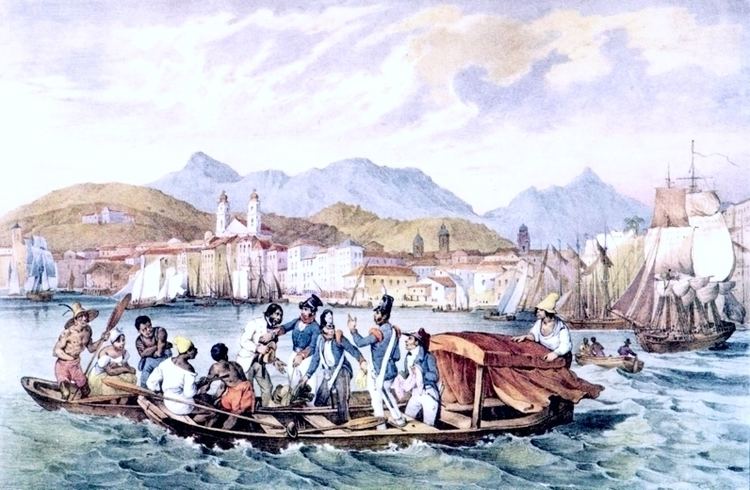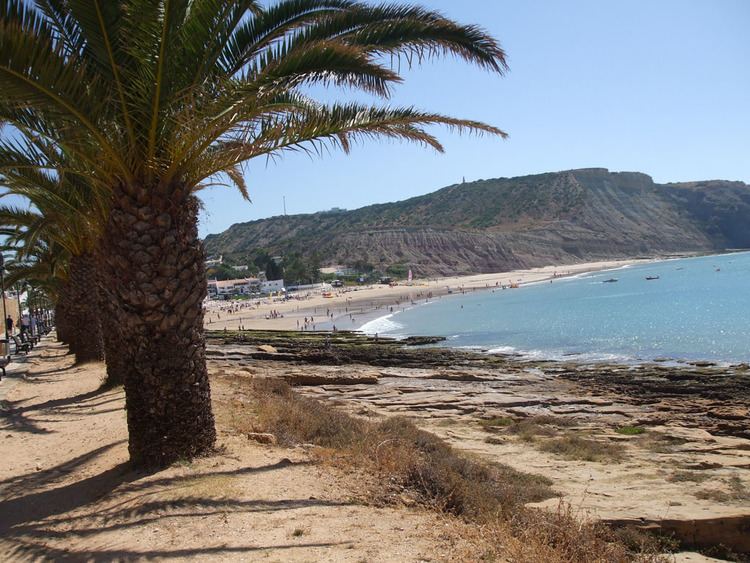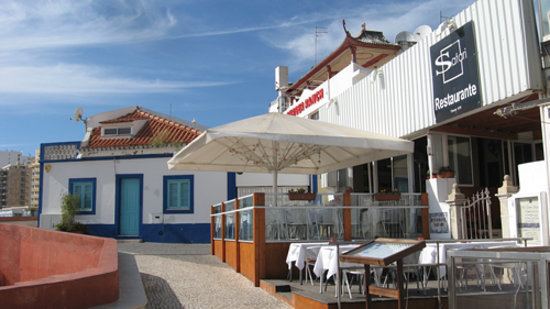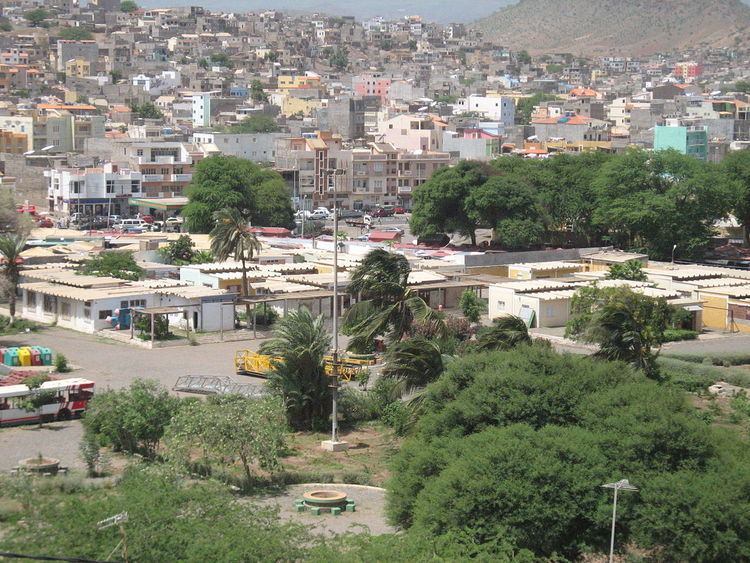Country | Population 61,644 (1990) | |
 | ||
Map of Praia
Praia ([ˈpɾajɐ], lit. "beach", in both Portuguese and Cape Verdean Creole), is the capital and largest city of Cape Verde, an island nation in the Atlantic Ocean west of Senegal. It lies on the southern coast of Santiago island in the Sotavento Islands group. It is the island's ferry port and is home to one of the nation’s four international airports. The city centre is known as Platô due to its location on a small plateau.
Contents
- Map of Praia
- Praia ribeira do cavalo
- Dia bem passado lagoa do ventopraia 31 03 2015
- Subdivisions
- History
- Geography
- Climate
- Demographics
- Education
- Economy
- 19th century
- Today
- Attractions and amenities
- Sports
- Notable residents and visitors
- Twin towns Sister cities
- References

Praia is Cabo Verde's largest city, a commercial centre, and a port that ships coffee, sugar cane, and tropical fruits. Praia also has a fishing industry and there are resort beaches nearby. It is the seat of the Praia municipality.

Praia ribeira do cavalo
Dia bem passado lagoa do ventopraia 31 03 2015
Subdivisions

The city (also the municipality) are divided into several neighbourhoods including:
History
The area what is now Praia was the Atlantic until around 500,000 years ago when the geologic formation enlarged the island especially when the sea level dropped to near its current level about 100,000 years ago. 73,000 years ago, the coastal area was strucked by a megatsunami made by the huge eruption from nearby Fogo and carrying large boulders onto a plateau at an elevation of 200 metres (660 ft). The waves were probably not as high as in the west as the cliffs are shorter than those in the west. During the Ice Age, around up to 50,000 years ago, its coastline was more than a kilometre south. Around 3,000 to 1,000 BC, Ilhéu de Santa Maria south of the present city separated from the island.
The area was first discovered along with the island by António da Noli in 1460. Later, the previous settlement was founded around the start of the 15th century, later most of the population were slaves. Before it was settled, the immediate neighbourhood were forested primarily with indigenous dragon trees and ironwood (laurisilva) and shrubs, parts of the area probably the east were a savanna, after some of these were cleared for agriculture as well as plantations. In 1527, it had its own captaincy which existed from 1526 to the 1580s. Its first captain was André Rodrigues dos Mosquitos, a year later it was Gomes Balieiro, capitains later were unknown, the next recorded in history was Manuel Correia who became on 21 January 1570 and was possibly the last captain of the captaincy. The settlement was razed by Francis Drake on November 29, 1585 as part of the Capture of Santiago, only the town hospital remained, the plunder was scarce and his fleet left.
The town of Praia de Santa Maria (Middle Portuguese: Praya) appeared in 1615 when it took the place of the previous settlement on the plateau, which was originally favored because the nearby port (Santa Maria beach or Gamboa) offered good conditions for ships. Initially used as a clandestine harbor (in order to avoid customs fees at the then capital Ribeira Grande), the settlement gradually acquired the characteristics of a town after much of the population from Ribeira Grande fled there during its decline in the midst of frequent pirate attacks. The official transfer of capital status from Ribeira Grande to Praia took place in 1770. Also Praia was the most used port in Portuguese Cape Verde up to the late 19th century, at nearly the same time the port of Las Palmas de Gran Canaria and Dakar, Senegal overcame the city's port activity.
Taken place at Praia Harbor, the Battle of Porto Praya took place on 16 April 1781, as Portugal was neutral, it involved Great Britain and France and ended in a tactical draw and French strategic victory.
In 1822, a riot broke out in Praia instigated by Manuel António Martins which overthrew António Pusich and put João da Mata Chapuzet as colonial governor, after that, he made the city that underwent large modernization, one of the buildings he designed was Quartel Jaime Mota, the other were at the arsenal and around the city square.
In the history of Cape Verde there have been successive proposals for transferring the capital elsewhere, its first was in 1834, the most recent being Mindelo in the late 19th century. However, the successive Portuguese administrations never showed an interest (economical or political?) in such proposals. Through an official decree in 1858, when its status was changed from town to city, Praia secured its status as the capital of Cabo Verde, concentrating political, religious and economic roles.
Until 1911, the city was known as Praya as well as the harbour (Porto Praya) and the Portuguese word for beach (praya) including one of a couple (Praya da Gambôa), under the Portuguese language Orthography Reform made by Portugal which removed the y and became replaced with an i, the Portuguese word for beach became praia as well as the city Praia, the harbour (Praia) and other beaches.
In the early 1920s, the population was around 21,000. On April 17, 1922, aviators Gago Coutinho and Sacadura Cabral flew a hydroplane for the First aerial crossing of the South Atlantic which arrived at the harbour as its stopover, it started from Lisbon, it came from Porto Grande Bay near Mindelo, it was the last stop before heading to Rio de Janeiro via Fernando de Noronha a day later. In 1927, it was the first city in Cape Verde to receive electricity.
As to other parts of the archipelago, resistance to Portuguese rule was rising in the late 19th century and continued up to July 1975. First its traditional music tabanka were banned by colonial governor Serpa Pinto in urban centers including Praia alongside funaná and batuque, the ban would be lifted after independence. Later, its review titled Certeza related to its colonial struggle was published in 1944, a milestone in Cape Verdean literature, it ceased publications a year later by the censors. In 1962, the first attacks took place in parts of Praia which were ordered by the guerrillas of the PAIGC, this started the struggle against the oppression of Portugal, months later the Guinea-Bissau War of Independence broke out in Portuguese Guinea (now Guinea-Bissau), due to logistical reasons, Cape Verde did not took part. During the Portuguese administration, only the central plateau was considered to be the city proper and thus the principal zone of urbanization and concentration of municipal services. It was only after independence (July 1975) that the surrounding neighbourhoods generally became accepted as part of the city proper.
Due to increasing beach sands at Gamboa, around 1960, the port's location moved east to the harbour's north at Ponta de Visconde and extended the land, the point is now Ponta do Porto.
After independence, the Praia underwent a demographic boom. After 33 years its population had quadrupled to 130,271, receiving migrating movements from all the islands. As a result, half of the entire population of Cabo Verde currently resides in Santiago; a fourth in the Municipality of Praia; and a fifth in the City of Praia alone. Its estimate population has reached 150,000.
On June 28, 1985, Praia became member of UCCLA, the Union of Luso - Afro-Americo-Asiatic Capital Cities, an international organization.
Geography
Geographically, Praia may be described as a set of plateaus and their surrounding valleys. These plateaus generally have the name achada (Achada de Santo António, Achada de São Filipe, Achada Eugénio Lima, Achada Grande, Achadinha, etc. — achada being a Portuguese word to designate a volcanic plateau), but the central one is colloquially called Plateau (in Portuguese itself). The urban settlement is made mostly on top of these plateaus and along the valleys. The islet of Santa Maria is in front of the beach bearing the same name (today more known as Gamboa).
For a long time, only the Plateau was considered to be the city, being the other neighbourhoods relegated to the condition of peripheral suburbs, in spite of always having a close relationship with the Plateau (people movements, goods and services exchanges, etc.). This is why only the Plateau previously had relatively well-developed urbanization with its own infra-structures. The remaining neighbourhoods developed in a more organic, chaotic way.
Only after independence did the Plateau merge with the other neighbourhoods to constitute what is now considered the City of Praia. The whole city was, at the time, equipped with adequate infrastructure. Urbanization begun immediately after independence and sought to expand north.
The Plateau is still attracting most of the daily traffic within the city because it is still considered the economic and administrative center of the city. In spite of de-centralization attempts, the population continues to consider the neighbourhoods peripherals to the Plateau, as either "bedroom communities" or industrial zones.
This was the first stop the HMS Beagle with Charles Darwin where he described the Iago sparrow (Passer iagoensis) When Edmund Roberts visited Praia in 1832, he noted a "good supply" of fish including mullet and red grouper. He also noted date palms being plentiful in the area.
Climate
Praia features a mild desert climate (Köppen: BWh) with a short wet season and a lengthy, very pronounced dry season. In fact, outside of the months of August, September and October, little precipitation falls on Praia. The city on average sees about 260 millimetres (10 in) of rain per year, between February and June, Praia has no rainy days, it has 8 rainy days in August. Since the coldest month is far above 18 °C (64 °F) its temperature patterns resembles a tropical climate, but lacks enough precipitation to be classified as such.
Despite the fact that it has an arid climate, Praia seldom gets very hot or very cold, due to its oceanside location on Santiago Island. Temperatures are warm and constant with an average high temperature of 27 °C (81 °F) and an average low temperature of 23 °C (73 °F).
Demographics
As of the mid-19th century, the population was estimated at 1,500 to 2,000. When Edmund Roberts visited in 1832, he noted a population of black people in Praia totaling about "nineteen twentieths" of the population.
Nowadays, Praia is truly a melting pot as every Cabo Verde Island is represented here by way of their natives, and many different nationalities are represented here as well.
According to the national statistics office, the city's population is approximately 134,782 as of December 2013, growing from 94,161 in 2000.
Education
The city of Praia is home to the first primary school in the archipelago, originally known as the Escola Central (today known as the Escola Grande). For much time it was the only primary school in Praia. At the beginning of the 1960s, other primary schools began to be built in neighbourhoods around the Plateau and in other localities on the island.
Praia was also the first site in Cabo Verde with a secondary education institution with the creation of the Liceu Nacional in 1861. However, the Portuguese authorities were not interested in implementing secondary education in Cabo Verde and the school failed as a result; secondary education became, afterwards, the role of the Seminário de Ribeira Brava on the island of São Nicolau, and later of the lyceum in Mindelo.
In 1960, Praia again had secondary education, first with a facility on September 12 Plaza and later in its own building. With the expansion of education in Cabo Verde in the 1990s, various buildings dedicated to education were constructed in Cabo Verde, and Praia currently (2016) has 12 secondary education schools.
International schools:
For higher education, there are the Instituto Universitário de Educação, Universidade Intercontinental de Cabo Verde, Universidade de Santiago, Instituto Superior de Ciencias Juridícas e Sociais, Instituto Superior de Ciencias Económicas e Empresariais, Jean Piaget University of Cape Verde, and University of Cape Verde.
Praia is also home to the National Library and the National Archives Building or the ANCV.
Economy
The economy of Praia is dependent above all on the services sector, with some industry as well.
Some industries exist, located on the coast (fishing) or in outlying neighbourhoods (rendering of agricultural products, materials for civil construction, etc.)
The principal economic activities of Praia belong to the tertiary sector. Beyond activities related to administration and governance (local and national), there are extensive commerce, services (health care, education, tourism, restaurants and hotels, public functions, etc.), and other activities of a liberal character.
Being the nation´s capital as well as the economic hub, Praia is one of the most economically viable cities in the Cabo Verde archipelago. About one third (1/3) of the city's population lives below the poverty line today (2014). The gross metropolitan product for the city is about 39% of the country's GDP, translating into US$4764 income per capita.
TACV Cabo Verde, the national airline of Cabo Verde, has its headquarters in Praia.
19th century
As of the mid-19th century, two roads accessed Praia, one from the east and one from the west, both traveling uphill. During this time, there were 45 cannons outfitting the roads for security of the region and the harbor. The harbor was utilized by ships from West Africa, South America, and the East Indies. September was the low visitation time for Praia by water, due to gale force winds that frequented during that month making harbor visits unsafe.
Today
The city is served by Nelson Mandela International Airport and TACV Cabo Verde Airlines. It has the nation's most used port, Praia Harbor, it is the only ferry terminal linking to other islands, direct ferry routes are Maio, Fogo and São Vicente. The last port expansion underwent in 2013 and finished in 2015.
There are numerous streets and avenues throughout the city, the main avenue are Avenida Amílcar Cabral, Avenida Cidade de Lisboa, Avenida Combatente da Liberdade da Patria, Rua do Aeroporto, these two opened in 2004, Avenida de Cuba, Rua da Várzea, Praia-Cidade Velha Road, Praia-Tarrafal Route, the Praia Circular Road opened in 2011, Caminho de São Francisco, the Port-Airport Route and Avenida Caixa Económica.
The city has Cape Verde's first modern transit system. Maura Company and Sol Atlántico are the only two companies that have been granted municipal bus service licenses. The city has 11 bus lines. Over the past decade, Maura Company, which had previously been the dominant bus company, has retired the majority of its buses, while many that continue to run are in a state of disrepair due to financial difficulties. Sol Atlántico, in contrast, has greatly increased its fleet of buses, adding several new high capacity buses in 2015. Municipal bus prices are regulated at 44 escudos per ride. Transfers are not allowed. Bus schedules do not exist, but buses start running around 6am and stop around 9pm. Bus stops exist, and are frequently infiltrated by minibus vehicles (also called "yasis") and both (taxi) licensed and unlicensed "clan" taxis illegally running municipal bus routes without a municipal license. In 2015 a project called EcobusCV started running a fleet of dual fuel waste vegetable oil / diesel modified Toyota HiACE minibuses using a scheduled service model between Praia and Assomada. Buses depart at a rate of one per hour, on the hour, from designated bus stops in Praia, at Igreja Nova Apostólica in Fazenda, and Assomada, in front of the court house. The current departure schedule as of September 15 is one departure per hour, every hour starting at 7am, with the last departure at 6pm. EcobusCV plans to expand to departures in 30 minute intervals before the end of 2015. EcobusCV has instituted aggressive, transparent pricing undercutting the informal generally accepted prices between municipalities, which has started to cause freelance yasis to alter their pricing.
Today, more than half of the city roads of Praia are paved as of 2015.
Attractions and amenities
Landmarks in the colonial city center include Albuquerque Square (named after the colonial governor of the mid 19th century, Caetano Alexandre de Almeida e Albuquerque), the old city hall built in the 1920s, the Presidential Palace, which was constructed in the end of the 19th century to house the Portuguese governor and the Monumento de Diogo Gomes, named after the Portuguese navigator who discovered the island of Santiago in 1460.
There is the Museu Etnográfico (Ethnographic Museum), which was founded in 1997. Some of the oldest buildings in Praia are Jaime Mota Barracks (Quartel Jaime Mota) dating from 1826.
Cabo Verde Telecom is headquartered in Praia just south of the plateau.
Sports
Praia is home to several sports teams. The most popular football (soccer) clubs include Sporting, Boavista, Travadores, Académica, Vitória and Desportivo; others include ADESBA, based in Craveiro Lopes; Celtic, based in Achadinha de Baixo; Tchadense, based out of Achada Santo Antônio; Delta, and Eugênio Lima, based in that neighbourhood. Basketball clubs include ABC Praia, Bairro and Travadores. Volleyball clubs include Desportivo da Praia. All are part of the Santiago League South Zone. Many clubs play at Estádio da Várzea.
Other or secondara stadiums includes Adega Sports Complex which is used for practices, Sucupira, Calabaceira, Achada Santo António, Ponta da Água (or Ponta d'Agua) and recently Achada Grande Frente
Notable residents and visitors
Twin towns — Sister cities
Praia is twinned with:
The city of Praia also has two official sister cities:
